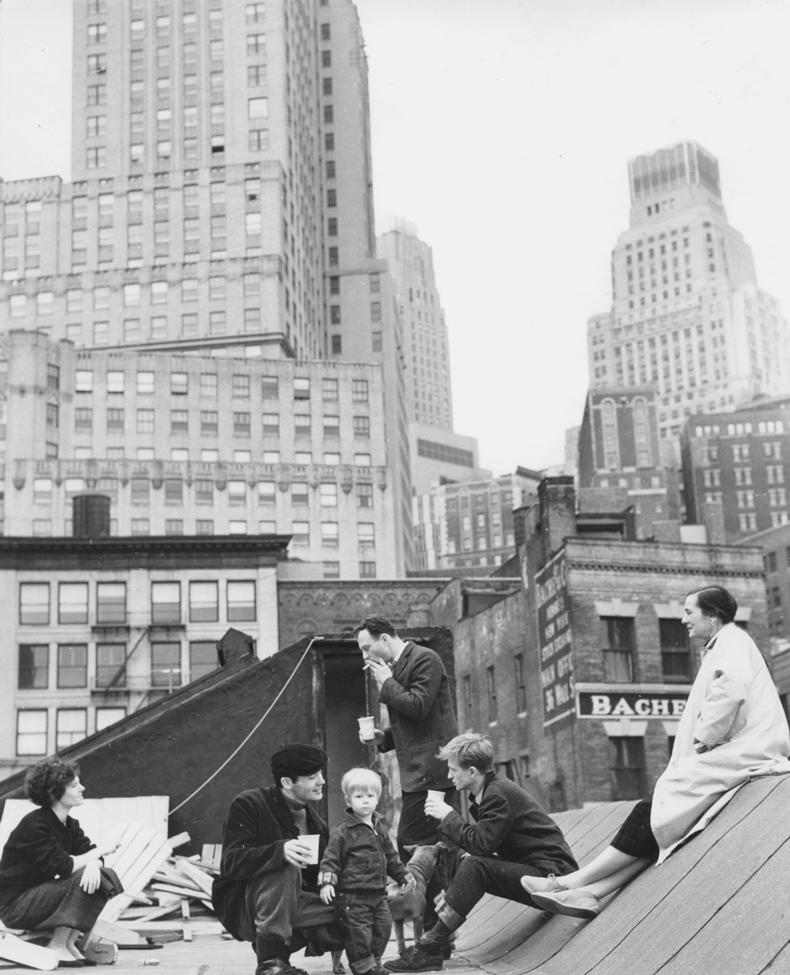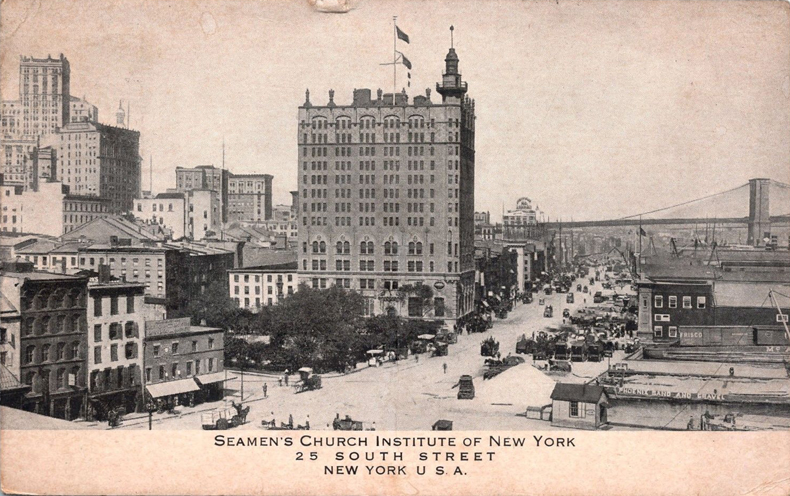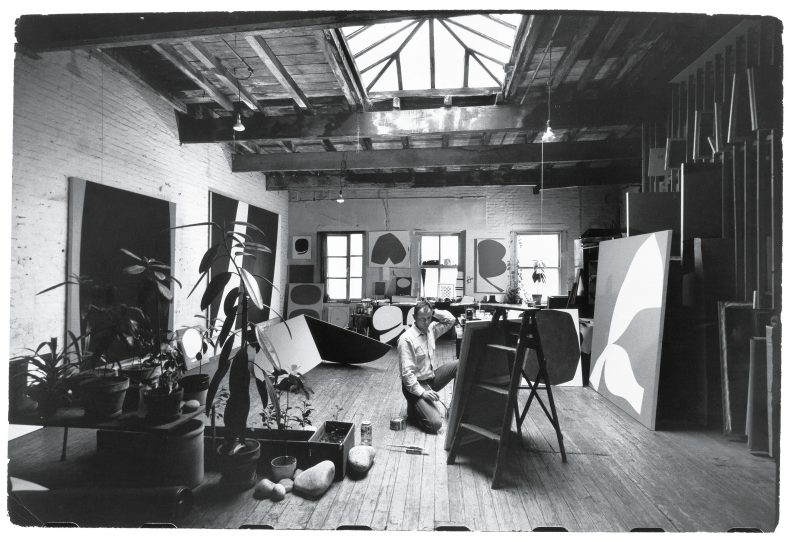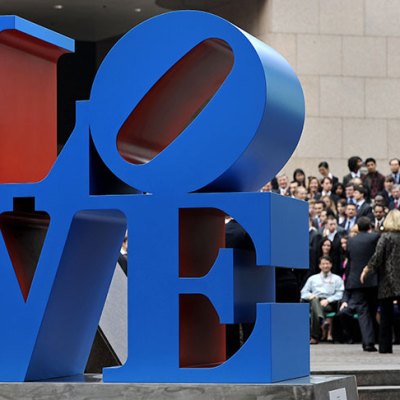From the January 2024 issue of Apollo. Preview and subscribe here.
This fabulously immersive history – the story of a time, but more crucially a place – starts with a set of photographs. The pictures, taken in 1958, feature a group of young artists who were living at that time on Coenties Slip, a wharfside block right at the tip of Lower Manhattan, from where you could smell the money on Wall Street and the fishmarket at Fulton Street. The artists in the photographs, Ellsworth Kelly, Robert Indiana, Agnes Martin, Jack Youngerman (and Youngerman’s wife, the French actress Delphine Seyrig), had found a loophole in the city’s zoning laws which allowed them to rent the abandoned sail lofts on the Slip for next to nothing, and to work at scale.
The photographs, taken for the Brussels World’s Fair at which Kelly was exhibiting, show them drinking coffee and smoking in trenchcoats on the roof of Kelly’s building, with the cliffs of financial district skyscrapers behind, or riding bikes on the deserted Sunday streets, or making art from the stuff they found around them.
Delphine Seyrig, Robert Indiana, Duncan Youngerman, Orange, Ellsworth Kelly, Jack Youngerman and Agnes Martin on the roof of 3–5 Coenties Slip, New York, photographed by Hans Namuth in 1958. Courtesy Center for Creative Photography, University of Arizona. © 1991 Hans Namuth Estate

There is an unspoken but fundamental character in the pictures: Coenties Slip itself. Peiffer, an art historian who is managing editor of the creative team at MoMA, uses the street to make a seductive argument, that ‘place is an undervalued determinant in creative output’. Her book is a group biography of artists, but one in which the protagonists are linked not so much by a manifesto or an ism, but by a shared set of coordinates on a map of old New York.
Peiffer establishes that location first with an account of its own backstory. It is a tale that begins with Dutch settlers – the Slip is named after Coenraedt Ten Eyck, a shoe-maker who arrived in the New World in 1651. In the 18th and 19th centuries as the city grew, the Slip was an entry point for tobacco and tea and sugar and people. Melville mentions it in Moby-Dick, and walked down there on lunchtime breaks from his work at the Customs House; the adjacent Seamen’s Church Institute was a port of call for 10,000 merchant mariners a day by 1930, many of whom also frequented waterfront saloons ‘unconstrained by contemporary morality’.
Seamen’s Church Institute of New York, 25 South Street (1915). New York Public Library

By the 1950s the Slip was adrift between two commercial worlds. The bustle of the wharves had faded and the waterfront real estate boom, which threatened demolition of the buildings, was only beginning. Artists were drawn to the liminal space like filings to a magnet. ‘The Slip artists all came from outside the city,’ Peiffer writes, ‘believing that it was here that something could happen.’
Youngerman and Kelly had met at the École nationale supérieure des Beaux-Arts in Paris, where they used their GI Bill grants to study painting. They went on pilgrimages to the studios of Brancusi and Jean Arp, before they returned separately to the States with plans to reimagine American art. They were joined on the Slip in 1957 by Agnes Martin, a watercolourist from New Mexico and later by James Rosenquist, who had been painting gas-station signs in Minnesota. Lenore Tawney, the textile artist, pitched up from Ohio; the sculptor Robert Clark, Kelly’s lover, took up residence and changed his surname to the state from which he came.
Agnes Martin in her Coenties Slip studio in New York in 1960. Photo: Alexander Liberman; © J. Paul Getty Trust, Getty Research Institute, Los Angeles

Peiffer gets much of the texture and grain of the group from Youngerman, whom she interviewed at length before he died in 2020. There is a wonderful recovered energy in her portrait of their separate efforts to move beyond the boys’ club of Abstract Expressionism (Jackson Pollock had died in 1956) that dominated New York galleries. We see Kelly looking out to the East River and the sweep of Brooklyn Bridge and feeling his way toward those defining curved monochromes. Meanwhile, a few doors down, Rosenquist was making his grandiose examinations of the American Dream before the Kennedy assassination and Martin, in her quilted boiler suit, was spending days and nights searching for order in a life dogged by bouts of schizophrenia in her grid paintings. The ghosts of old Coenties Slip – that long past of ambition and rough work and licence – seemed to come up through the boards. Often, the relics of that history offered direct inspiration for making new. Peiffer details how Indiana repurposed wooden beams and old ships’ stencils for prototype Pop pieces; Tawney, at number 27, undid all received ideas of weaving using old rigging left in her studio space.
Inevitably, though their work was determinedly separate, the lives of the artists became – briefly – as entangled as one of Tawney’s wall hangings. They shared breakfast muffins and long walks by the river, and late nights drinking whisky in each other’s studios; they propped up Martin as she struggled with her mental health and helped each other find space to exhibit.
Ellsworth Kelly at his Coenties Slip studio in New York in 1961. Photo: Fritz Goro; courtesy Ellsworth Kelly Studio

If Kelly was in many ways the connecting thread – his relationship with Indiana and the broken-hearted fallout was a prime mover in the creation of Indiana’s famous LOVE stencil of 1964 – it was, Peiffer shows, the warehouse buildings themselves that gave the group their special character. As the careers took off, there was a built-in ending to that setting: by 1964 all the buildings in Coenties Slip had been condemned. But not before, Peiffer argues, they had provided ‘a model of creativity that is not about a movement’, but about proximity. About the liberating knowledge that ‘there are others around you – above and below, just down the block – who are also trying to work out how to make something compelling, and how to survive while doing that’.
The Slip: The New York City Street that Changed American Art Forever by Prudence Peiffer is published by Harper Collins.
From the January 2024 issue of Apollo. Preview and subscribe here.



